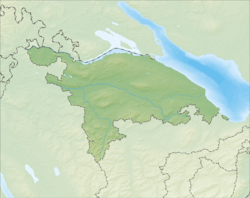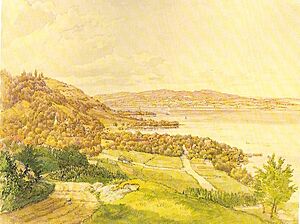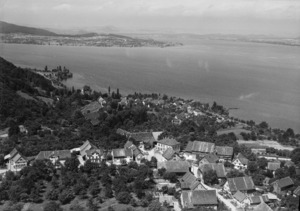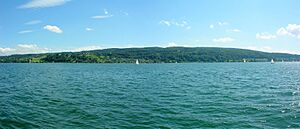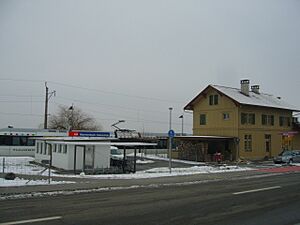Salenstein facts for kids
Quick facts for kids
Salenstein
|
||
|---|---|---|
 |
||
|
||
| Country | Switzerland | |
| Canton | Thurgau | |
| District | Kreuzlingen | |
| Area | ||
| • Total | 6.54 km2 (2.53 sq mi) | |
| Elevation | 400 m (1,300 ft) | |
| Population
(Dec 2020 )
|
||
| • Total | 1,411 | |
| • Density | 215.75/km2 (558.8/sq mi) | |
| Postal code |
8268
|
|
| Surrounded by | Berlingen, Ermatingen, Gaienhofen (DE-BW), Raperswilen, Reichenau (DE-BW) | |
Salenstein is a town in Switzerland, located in the Thurgau region. It's famous because Napoleon III, a future emperor, lived there when he was young at Castle Arenenberg.
Contents
A Look at Salenstein's Past
Long, long ago, around 750-450 BC, people from the Hallstatt culture lived near Salenstein. We know this because burial mounds (ancient graves) have been found in the Eichholz area.
The modern village of Salenstein was first mentioned in records in 1092. Around the 11th century, Salenstein Castle was built. It was a home for knights who worked for Reichenau Abbey. Later, two smaller castles, Sandegg and Riederen, were also built for more officials.
In 1401, a noblewoman named Clare of Breitenstein started a special house for religious women in the Götschen woods. It was called Blümlistobel. This house was later rebuilt after a fire in 1534. The last sister lived there until 1545.
Life was sometimes hard for the villages of Mannenbach and Salenstein. In 1573, they had to use their shared forest as a guarantee for a loan because they were in debt.
Salenstein has a mild climate, which is great for growing wine, cherries, and other garden plants. In the 1700s, many people started working from home, making things like woven fabrics and knitted goods.
A big change happened in 1817 when Hortense de Beauharnais, the former Queen of Holland, bought Castle Arenenberg. She was living in exile and made the castle her home. This created new jobs for the people of Salenstein. After some quiet years, Salenstein started to grow again after 1950. Today, it has one of the lowest tax rates in the Thurgau region.
Salenstein's Location and Landscape
Salenstein covers an area of about 6.54 square kilometers (2.5 square miles). A large part of this area, about 35%, is used for farming. Even more, about 50%, is covered by forests. The rest of the land, about 13.6%, has buildings and roads.
The town is located on a hill called Seerücken, between the towns of Berlingen and Ermatingen. Salenstein includes the main village and two smaller communities called Fruthwilen and Mannenbach.
People of Salenstein
Salenstein has a population of about 1,244 people. Many people in Salenstein speak German, which is the most common language. Some also speak Portuguese and Albanian.
The population of Salenstein has grown over the years. In 1850, there were about 890 people, and by 2000, it had grown to over 1,100.
Here's how the population has changed over time:
| year | population |
|---|---|
| 1850 | 890 |
| 1860 | 857 |
| 1870 | 864 |
| 1880 | 801 |
| 1890 | 786 |
| 1900 | 782 |
| 1950 | 850 |
| 1960 | 921 |
| 1980 | 882 |
| 1990 | 986 |
| 2000 | 1,108 |
Important Historical Buildings
Salenstein is home to three important castles: Arenenberg, Eugensberg, and Louisenberg. These, along with the St. Aloysius chapel in Mannenbach, are recognized as important Swiss heritage sites. The villages of Salenstein and Mannenbach are also part of a special area known for its historical value.
Arenenberg Castle's Story
thumb|Arenenberg Castle Arenenberg Castle was built in the early 1500s. It had many owners over the years. In 1817, Hortense de Beauharnais, the daughter of Empress Joséphine and former Queen of Holland, bought it. She was married to Louis Bonaparte, Napoleon's brother.
Hortense loved Arenenberg and made many changes to make it beautiful. Her son, Louis Napoléon, who would later become the Emperor of France, spent his teenage years here. He studied at Arenenberg and even became a Swiss citizen.
After Hortense passed away in 1837, Louis Napoléon had to leave Switzerland. He sold the castle in 1843. But once he became emperor, his wife, Empress Eugénie, bought it back in 1855. She also made more improvements to the castle.
After Napoleon III died, Empress Eugénie visited Arenenberg many times. In 1906, she generously gave the castle to the Canton Thurgau. Today, it is a museum where you can learn about its royal past.
Working and Living in Salenstein
In 2005, Salenstein had many different types of jobs. Some people worked in farming, others in manufacturing, and many more in services like shops and offices.
Many people who live in Salenstein travel to other towns for work. About half of the residents work outside Salenstein. However, some people also travel into Salenstein for their jobs. Most people use a private car to get to work, but some use public transportation.
Religion in Salenstein
According to a census from 2000, about 28.7% of the people in Salenstein were Roman Catholic. A larger group, about 51.6%, belonged to the Swiss Reformed Church. There were also smaller numbers of people who were Islamic or belonged to other Christian churches. About 12.6% of the population did not belong to any church.
Getting Around Salenstein
Salenstein is located on the Lake Line, which is a railway line between Schaffhausen and Rorschach. The town has its own train station, Mannenbach-Salenstein railway station, which is part of the St. Gallen S-Bahn network. This makes it easy for people to travel to and from Salenstein.
Learning in Salenstein
Education is important in Salenstein. Many adults (between 25 and 64 years old) have completed higher education, like university or specialized schools.
Salenstein has its own combined municipal and primary school district. In the 2008/2009 school year, there were 66 students. This included children in kindergarten and primary school. The average class size in primary school was about 16-17 students.
Images for kids
See also
 In Spanish: Salenstein para niños
In Spanish: Salenstein para niños




